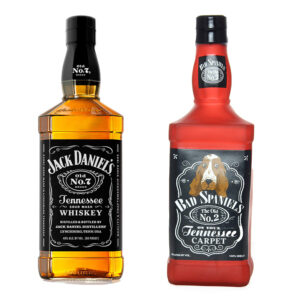Supreme Court to determine whether parody is only mostly dead
On March 22, 2023, the United States Supreme Court will hear oral arguments in the case Jack Daniel’s Properties, Inc. v. VIP Products, LLC.¹ It is more commonly known as the “Bad Spaniels” case where VIP Products sells chew toys for dogs which not-so-coincidentally evoke features of the bottle shape and designs for Jack Daniel’s whiskey products. See for yourself:

VIP Products intentionally designed its product line to be a parody of a variety of known beer, wine, soda, and liquor bottles. The “Bad Spaniels” version directly sought to parody Jack Daniel’s whiskey bottle and associated features. VIP Products admittedly sought to “match the bottle design.” The finished product incorporated all features of the Jack Daniel’s brand: the bottle shape, color scheme, and the font and stylization. Even the name sounds phonetically similar.
Jack Daniel’s not surprisingly sued VIP Products for trademark infringement, trade dress infringement, tarnishment, and trademark dilution – while asserting that its name and brand, including the bottle shape, are famous trademarks. In response, VIP Products claims that its parody products are protected by the First Amendment. VIP Products also asserted defenses of fair use, including nominative fair use.
The trial court in Arizona originally found in Jack Daniel’s favor and issued a permanent injunction. VIP Products immediately appealed and re-asserted the same defenses to the Ninth Circuit. This is where the case became messy.
The Ninth Circuit found that the Jack Daniel’s trademark(s) are valid and enforceable. It also held that VIP Products is not entitled to rely on a nominative fair use defense to avoid infringement. However, the Ninth Circuit reversed the dilution and infringement claims. The appeals court determined that the “humorous message” conveyed by the “Bad Spaniels” product line was potentially an expressive work that might fall within the construct of a protected parody. This necessarily includes First Amendment considerations. The Ninth Circuit remanded the case back to the trial court to apply what is known as the Rogers test.²
The Rogers test is based on the following principle: a trademark owner does not have an actionable claim unless the third-party use of the trademark is either (1) not artistically relevant to the underlying work or (2) explicitly misleads consumers as to the source or content of the work.³ On remand, the trial court applied the Rogers test to the “Bad Spaniels” product line and concluded that the parody line was sufficiently artistically relevant because it used the Jack Daniel’s marks to “communicate a message.” The trial court also held that the “Bad Spaniels” product line does not “explicitly mislead” consumers because VIP Products “altered nearly every element with its own expressive content.” This new expressive content was determined to fall within First Amendment protections. Thus, the Jack Daniel’s marks were found neither infringed nor diluted by “Bad Spaniels.”
The trial court’s application of Rogers found in favor of VIP Products – but the court cautioned that “it appears nearly impossible for any trademark holder to prevail under the Rogers test.” Despite these concerns, the Ninth Circuit affirmed the trial court’s Rogers fact findings on March 18, 2022. Jack Daniel’s immediately sought assistance from the United States Supreme Court, which granted certiorari on November 21, 2022. Surprisingly, the Biden administration joined the dispute and filed an amicus brief in support of Jack Daniel’s – claiming that the Rogers test improperly bypasses the likelihood of confusion standard for trademark infringement. The brief suggested that whether a work is a parody should merely be part of the likelihood of confusion analysis, but not a standalone carve-out or safe harbor exception.
The “Bad Spaniels” case presents a substantial challenge to the Court. Parody is a necessary medium for communication. The Rogers test incorporates this fact, but does not provide any bright-line guidance that works in tandem with the likelihood of confusion test. Trademark owners are entitled to some degree of certainty regarding the degree to which a third-party can make unauthorized use of trademarks, including trade dress. This is especially true for marks that may be “famous” marks – as those are the more likely targets for parody. More specifically, unauthorized users of trademarks should not be provided an unlimited safe harbor just because their use is intended to be humorous. (This also encourages disingenuous claims by infringers of “it was a joke!” simply to avoid an injunction.) As indicated by the trial court’s warning, the Rogers test as applied may provide too high of a burden for a trademark owner to overcome before the likelihood of confusion test begins.
As a result, the Supreme Court is once again tasked with providing guidance for litigants when First Amendment principles potentially conflict with trademark rights. Trademarks only exist for marks that are actively used in commerce, which means the Court is again assessing the merits of “commercial speech,” which can be more restricted and regulated than “private speech.” Nevertheless, there remains a tension between the First Amendment and existing trademark laws which must be resolved.
David Clark is a Senior Counsel at McCathern’s office in Houston, Texas. He focuses his practice on business and commercial litigation, intellectual property, and media and entertainment matters.
¹ No. 21-16969, 2022 WL 1654040 (9th Cir. Mar. 18, 2022); No. CV-14-02057-PHX-SMM, 2021 WL 5710730 (D. Ariz. Oct. 8, 2021)
² See generally Rogers v. Grimaldi, 875 F.2d 994 (2d Cir. 1989)
³ Dr. Seuss Enters., L.P. v. ComicMix LLC, 983 F.3d 443, 462 (9th Cir. 2020) (emphasis added)